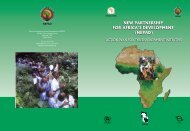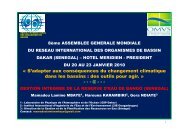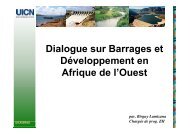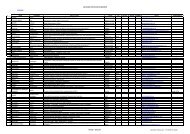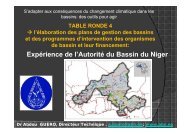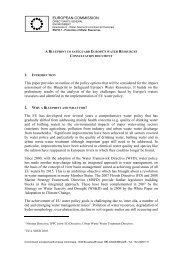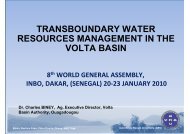The Past and the Future of Flood Management in the Eastern ... - INBO
The Past and the Future of Flood Management in the Eastern ... - INBO
The Past and the Future of Flood Management in the Eastern ... - INBO
You also want an ePaper? Increase the reach of your titles
YUMPU automatically turns print PDFs into web optimized ePapers that Google loves.
Regional Background<br />
<strong>The</strong> countries <strong>of</strong> <strong>the</strong> <strong>Eastern</strong> Nile Region are Egypt, <strong>the</strong> Sudan <strong>and</strong> Ethiopia. Ma<strong>in</strong> rivers<br />
<strong>of</strong> <strong>the</strong> <strong>Eastern</strong> Nile region rise <strong>in</strong> <strong>the</strong> Ethiopian Highl<strong>and</strong>s <strong>in</strong> <strong>the</strong> western half <strong>of</strong> Ethiopia<br />
<strong>and</strong> dra<strong>in</strong> generally westerly or north-westerly <strong>in</strong>to <strong>the</strong> Sudan where <strong>the</strong> White Nile <strong>and</strong><br />
<strong>the</strong> Ma<strong>in</strong> Nile dra<strong>in</strong> generally north, <strong>and</strong> <strong>the</strong>n <strong>the</strong> Nile flows fur<strong>the</strong>r north through Egypt<br />
to <strong>the</strong> Mediterranean Sea.<br />
Ethiopia <strong>and</strong> Sudan experience tropical or sub-tropical climates, with ra<strong>in</strong>fall seasonally<br />
biased <strong>and</strong> most ra<strong>in</strong> fall<strong>in</strong>g <strong>in</strong> <strong>the</strong> summer months (June to August). Temperatures <strong>and</strong><br />
annual ra<strong>in</strong>fall depths vary widely, depend<strong>in</strong>g on elevation. Parts <strong>of</strong> <strong>the</strong> Ethiopian<br />
highl<strong>and</strong>s receive average annual ra<strong>in</strong>fall exceed<strong>in</strong>g 2000 mm, while <strong>in</strong> far nor<strong>the</strong>rn<br />
Sudan <strong>and</strong> Upper Egypt <strong>the</strong>re is very little ra<strong>in</strong> at all.<br />
Ethiopia:<br />
Ethiopia covers a l<strong>and</strong> area <strong>of</strong> 1.133 million km 2 , <strong>of</strong> which just over 358 000 km 2 is<br />
located <strong>in</strong> <strong>the</strong> <strong>Eastern</strong> Nile river bas<strong>in</strong>. <strong>The</strong> population <strong>of</strong> Ethiopia is approximately 70<br />
million <strong>and</strong> 85% <strong>of</strong> <strong>the</strong> national population relies on smallholder subsistence agriculture.<br />
In <strong>the</strong> Tekeze <strong>and</strong> Abbay sub-bas<strong>in</strong>s impacts <strong>of</strong> flood<strong>in</strong>g are generally m<strong>in</strong>or because<br />
most <strong>of</strong> <strong>the</strong> population lives on elevated plateaus <strong>and</strong> not <strong>in</strong> <strong>the</strong> deep river valleys.<br />
Sporadic flash flood<strong>in</strong>g has been noted <strong>in</strong> several areas. <strong>The</strong> ma<strong>in</strong> exception is around<br />
Lake Tana, particularly where flat pla<strong>in</strong>s adjo<strong>in</strong> <strong>the</strong> lake. <strong>The</strong> lowl<strong>and</strong>s <strong>of</strong> <strong>the</strong> Baro-<br />
Akobo sub-bas<strong>in</strong> are also partially <strong>in</strong>undated by floodwaters every year.<br />
Sudan:<br />
Sudan is <strong>the</strong> largest country <strong>in</strong> Africa <strong>in</strong> terms <strong>of</strong> <strong>the</strong> area <strong>of</strong> its territory – approximately<br />
2.5 million km 2 . <strong>The</strong> population <strong>of</strong> <strong>the</strong> Sudan is approximately 38 million, <strong>of</strong> which<br />
approximately 6 million reside <strong>in</strong> greater Khartoum at <strong>the</strong> confluence <strong>of</strong> <strong>the</strong> Blue <strong>and</strong><br />
White Niles. <strong>The</strong> annual flood from <strong>the</strong> Blue Nile (Abbay <strong>in</strong> Ethiopia) replenishes soil<br />
moisture <strong>and</strong> fertility, <strong>and</strong> recharges groundwater, so is <strong>the</strong> ma<strong>in</strong>stay <strong>of</strong> agriculture <strong>in</strong><br />
much <strong>of</strong> <strong>the</strong> country. Hundreds <strong>of</strong> villages l<strong>in</strong>e <strong>the</strong> banks <strong>of</strong> <strong>the</strong> Blue Nile <strong>and</strong> Ma<strong>in</strong> Nile,<br />
<strong>and</strong> because <strong>of</strong> <strong>the</strong>ir proximity to <strong>the</strong> river banks are adversely affected <strong>in</strong> years <strong>of</strong> above<br />
average floods. In large floods, lower-ly<strong>in</strong>g riparian l<strong>and</strong> <strong>in</strong> Khartoum may be <strong>in</strong>undated,<br />
<strong>and</strong> <strong>the</strong> city <strong>of</strong> Dongola is at frequent risk from floods.<br />
Egypt:<br />
<strong>The</strong> l<strong>and</strong> area <strong>of</strong> Egypt is just under 1 million km 2 . <strong>The</strong> population <strong>of</strong> Egypt is currently<br />
about 75 million, most <strong>of</strong> who reside along <strong>the</strong> narrow strip <strong>of</strong> <strong>the</strong> Nile River valley or<br />
around <strong>the</strong> river delta. <strong>The</strong> High Aswan Dam (HAD) was completed on <strong>the</strong> River Nile <strong>in</strong><br />
upper Egypt <strong>in</strong> 1970, <strong>and</strong> generation <strong>of</strong> hydropower <strong>and</strong> regulation <strong>of</strong> water for irrigation<br />
by HAD has become a ma<strong>in</strong>stay <strong>of</strong> <strong>the</strong> Egyptian economy. While HAD has had a major<br />
mitigation effect on downstream flood<strong>in</strong>g, a series <strong>of</strong> high flood years <strong>in</strong> 1998 to 2001<br />
proved that flood risk management is still on <strong>the</strong> agenda for <strong>the</strong> government <strong>of</strong> Egypt.<br />
3



